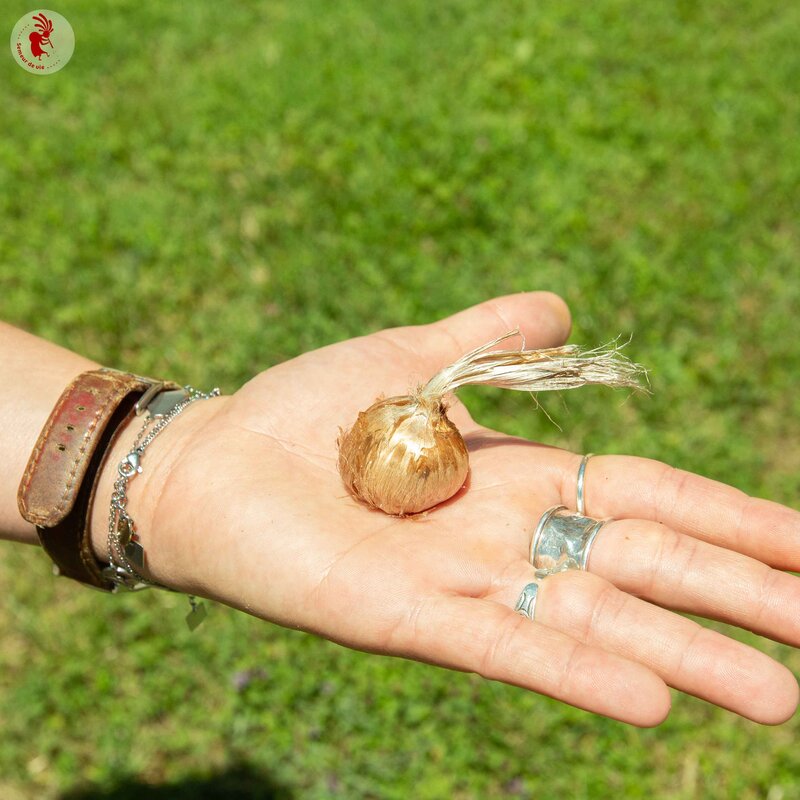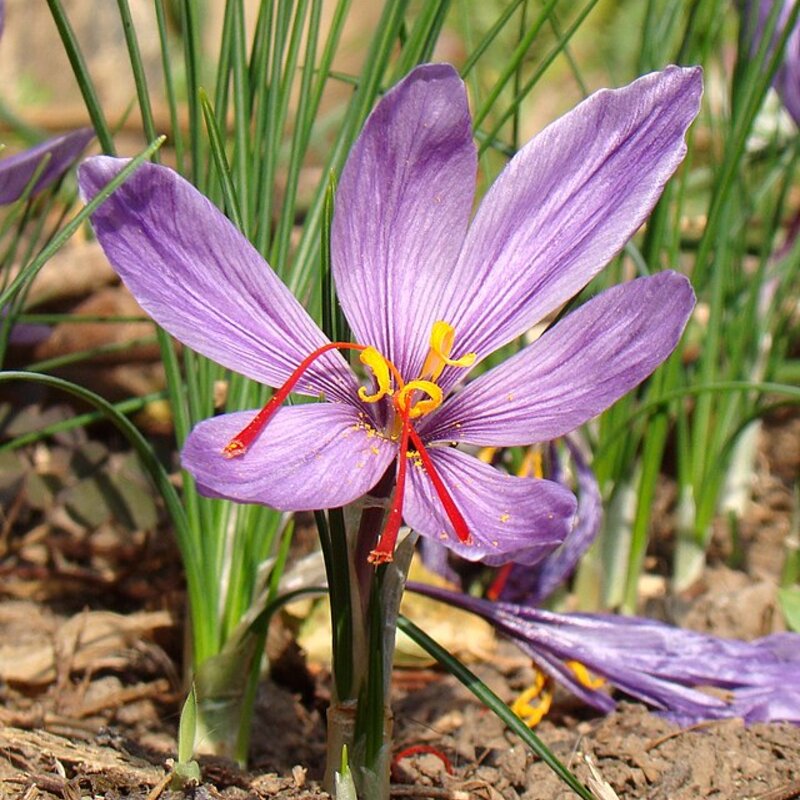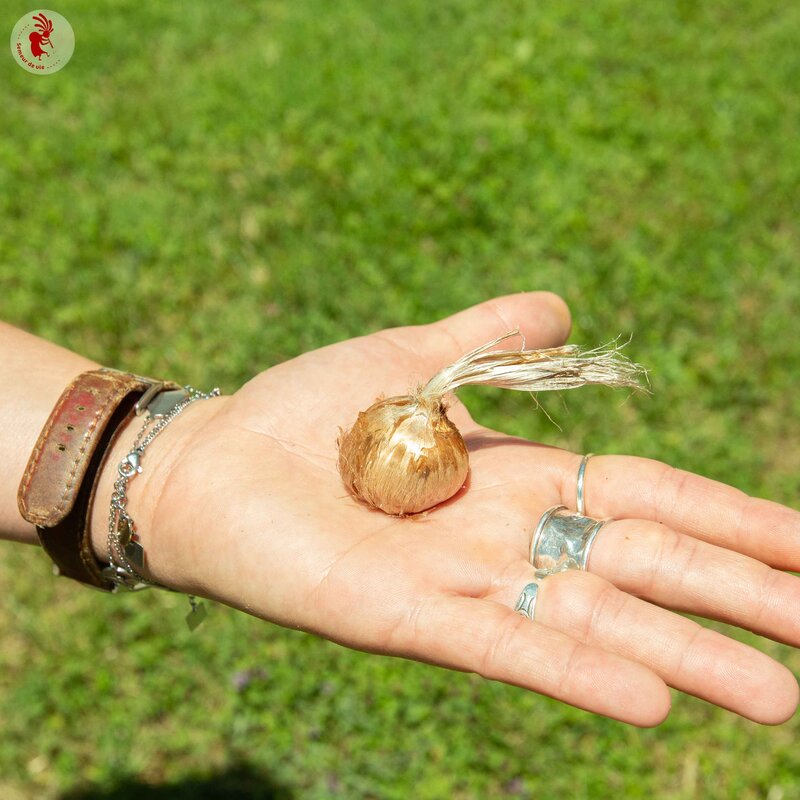Saffron bulb - Crocus sativus (calibre 9-11)
Crocus sativus bulbs will be available for sale again at the end of June 2024.
Crocus sativus, the only species capable of producing saffron, is a 15 cm-tall bulbous plant whose violet flowers provide 3 yellow stamens and 3 red stigmas. Saffron bulbs of sizes 8-9 (8-9 cm circumference), 9-11 (9-11 cm circumference) and 11-13 (11-13 cm circumference) produce flowers from the first year.
Organic French saffron since the 15th century. Crocus sativus bulbs are propagated and harvested in France by Safranière du Luberon (84).
What is Crocus sativus saffron?
Saffron, also known as "Red Gold", has been prized for its medicinal properties since Antiquity and Ancient Greece, and is a staple of Oriental and Mediterranean cuisine.
To produce 1 gram of saffron, you need between 150 and 200 flowers! Even if you need very little of this spice to flavor a dish, it's expensive because of the labor required to harvest the stigmas (the spicy part of the flower).
This lucrative market encourages many unscrupulous dealers to resell "doctored" saffron powder at prices ranging from 15,000 to 20,000 euros per kilo.
Its magnificent flowers feature 6 violet tepals (parts of the floral envelope whose sepals and petals are indistinguishable), 3 yellow stamens and 3 reddish-brown stigmas.
Growing saffron yourself is within the reach of all gardeners: beginners, experienced or confirmed. In a window box or in the ground, a good exposure to the sun and a few simple recommendations are all you need to enjoy this spice with its honeyed taste and metallic notes.
When to plant crocus sativus bulbs?
The appearance of sprouts on Crocus sativus in no way alters their quality, and poses no problem when planting them.
From late June to mid-September, in soil or pots, at a depth of 15 to 25 cm, plant organic saffron crocus bulbs, size 9-11, point upwards, spaced 8 to 12 cm apart (preferably in drained soil rich in organic matter).
Do not water the plants. Saffron bulbs do not tolerate heat and humidity, and risk rotting.
Every 2-3 years, remove bulbs and replant elsewhere in the garden. Crocus sativus bulbs are very greedy and deplete the soil's resources. This weakening of the soil is conducive to the development of disease and other pathogens.
How to propagate saffron bulbs?
The Crocus sativus species multiplies. From one year to the next, the bulbs will produce bulblets which, once developed, will in turn produce saffron flowers!
Don't throw away pots and plants! From March to September, saffron bulbs are in a state of dormancy, and will restart their life cycles in autumn.
In autumn, as soon as temperatures start to drop, saffron stems start to grow. Water only if there's no rain. If you're short of water, when the weeds reach a sufficient height (5 to 10 cm) water the plant and the flowers will follow. Remember to pull out weeds so that the saffron plant grows comfortably in the soil.
How to harvest saffron pistils?
In October, gently remove the saffron flowers early in the morning, once the dew has evaporated and before the petals open. Once harvested and opened, the flowers are pruned. This operation, which must be carried out on the day of harvest, consists of extracting the 3 red stigmas (spices). They can be picked by hand or with tweezers.
How to dry saffron pistils?
Once the flowers have been pruned, place the stigmas in a stainless steel sieve (e.g. a flour sieve). For optimum drying without altering the quality of the saffron, place the sieve with the pistils in the oven for 15 to 20 minutes at 50°C. To check that the spice is dry, weigh the stigmas before and after drying. They should lose 4 to 5 times their weight.
It's important to dry the flower stigmas directly after harvesting.
Once dried, store saffron (dried stigmas) in an airtight glass jar, away from light. To enjoy its full flavor, let the organic saffron spice mature for 3 months before eating.
Where do Crocus sativus saffron bulbs come from?
Crocus Sativus bulbs, caliber 9-11, are propagated in southeastern France by Safranière du Luberon. The strains of these bulbs come from the Conservatoire du Safranério, which preserves the biodiversity of saffron and the species by conserving its strains, with the help of members who propagate them according to strict specifications. Open to all, the Safranério Conservatory provides traceability for organic saffron plantations and guarantees the parentage of Crocus sativus bulbs.






















